- Prelude
- Hard Talk
- New Media
- Rolex : An Overview
- The age of Revivals: Neoclassical Furniture
- Democratization of the Medium No-Budget film: the Indian Context (!)
- Old Sound New Sound
- Decan Odyssey
- North East Opsis
- Russian cool breeze in hot Paris
- Around Kolkata
- Musings from Chennai
- In and around Santiniketan
- In between – from Vadodra
- A Tryst with Art in Madhya Pradesh
- Through the Looking Glass
- The Foreign Connection
- Market Insight
- Market Report
- Artist Index and Statistics
- Auction Reports
- The month that was
- Delhi Dias
- Art Bengaluru
- Mumbai Art Sighting
- Creative Impulse
- Subodh Gupta
- Pooja Iranna
- Preview
- In the News
ART news & views
Decan Odyssey
Volume: 2 Issue No: 9 Month: 10 Year: 2010
Free Speech and the Art of Sheryl Oring
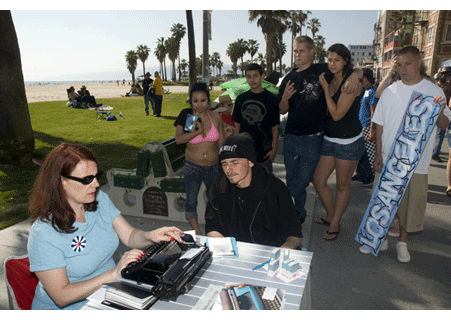
“I wish to Say” the words from the poem by Gertrude Stein obtained a new meaning in the performance oriented work of Sheryl Oring. 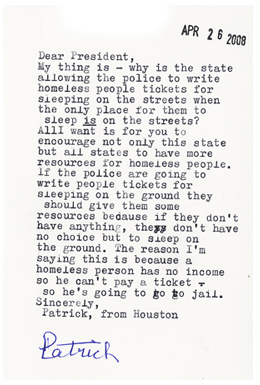 Sheryl Oring grew up in North Dakota, attended college in Colorado and then moved to California to pursue journalism; thereafter she left for Germany to study art theory.
Sheryl Oring grew up in North Dakota, attended college in Colorado and then moved to California to pursue journalism; thereafter she left for Germany to study art theory.
The exhibition of post cards by the artist was shown in an Art Foundation in Hyderabad in March and April 2007.Speaking about the exhibition is relevant in terms of bringing in to wider knowledge Sheryl's intervention to disseminate public opinion through creative means.
The conceptual and performative work that began from 2004, put in view the artist at work, corresponding many roles, in order to project people's view in the context of contemporary America. The work shows a documentative approach of a historian, a therapist bringing out issues and anxieties, balancing at the same time minimalistic aesthetes. A sense of play is also conveyed as the artist dresses up to explore history. The project involved passers-by to write a postcard to President Bush. She provided the card and the stamp for the messages.
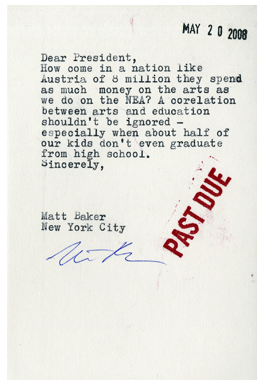 During the Republican National Convention in New York City Sheryl dressed up in a 1950's style attire, set up a secretarial space with an antique typewriter bought from a New York shop. The typewriter attracted the people. It was chosen to play the role of a symbol, reminding everyone of a different era when people had the time and need to write letters, when people slowed down and listened to each other.
During the Republican National Convention in New York City Sheryl dressed up in a 1950's style attire, set up a secretarial space with an antique typewriter bought from a New York shop. The typewriter attracted the people. It was chosen to play the role of a symbol, reminding everyone of a different era when people had the time and need to write letters, when people slowed down and listened to each other.
The project got extended further as Sheryl felt the need to carry her project out of New York and go around the country. This enabled her to reconnect to an extent with her place of origin after living outside the country for six years. During this time another 1200 postcards were generated.
Sheryl's response to a news channel in September 2004 stated that her idea for 'I Wish to Say' partly came from the feeling that she wanted to give people across the country a way to be expressive. Sheryl observed a complacency in the news paper reportage as collection of news from established sources was showing up rather than the views of Ordinary people.
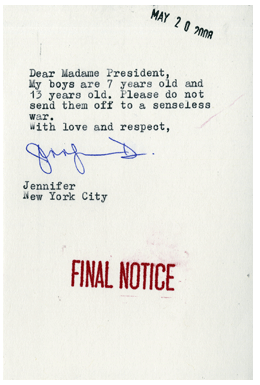 Sheryl's articulacy on the subject of suppression of speech and the book burning in Nazi Germany throws light on her long standing academic interest in free speech. This played an integral role in attributing significance to “I Wish to Say” which evolved in to a special edition in 2006, as the Birthday project, corresponding to the sixtieth Birthday of the President of America.
Sheryl's articulacy on the subject of suppression of speech and the book burning in Nazi Germany throws light on her long standing academic interest in free speech. This played an integral role in attributing significance to “I Wish to Say” which evolved in to a special edition in 2006, as the Birthday project, corresponding to the sixtieth Birthday of the President of America.
Sheryl's choice in role playing, costume and the typewriter as the conveyance of messages is reminiscent of 1960's. Thus an assimilation of many elements from the period of which the service oriented role of women, the inception of People's communication with the Government were perceptible. As Sheryl would set up her secretarial space in public places people would come up to her in a state of curiosity and that would begin the whole process of listening intently to what they had to say. She would simultaneously type the messages in a non judgmental manner.
 Each show was conducted over a stretch of two to three hours and an average of 30 to 40 communications was typed. The little space in the cards could only hold concise messages but the results were powerful. People sometimes did not want to get a card made as they did not know of the consequences. The project surfaced with concerns of common people, about deportments, relatives in Iraq were issues of apprehension. The mention of the Iraq war that had disappeared from the media still generated a sense of disquiet amongst people. Sheryl reflects that while doing the cards people felt that they were listened to and this brings a sense of satisfaction to the artist.
Each show was conducted over a stretch of two to three hours and an average of 30 to 40 communications was typed. The little space in the cards could only hold concise messages but the results were powerful. People sometimes did not want to get a card made as they did not know of the consequences. The project surfaced with concerns of common people, about deportments, relatives in Iraq were issues of apprehension. The mention of the Iraq war that had disappeared from the media still generated a sense of disquiet amongst people. Sheryl reflects that while doing the cards people felt that they were listened to and this brings a sense of satisfaction to the artist.
The idea for the project firmed up as a result of being exposed to a common European opinion that all Americans think alike, Sheryl's experience of travel and living in many parts of the country made her think that this couldn't possibly be true. This project essentially brings out the fact to the world the diverse contexts, opinions and issues that people of America are concerned with.
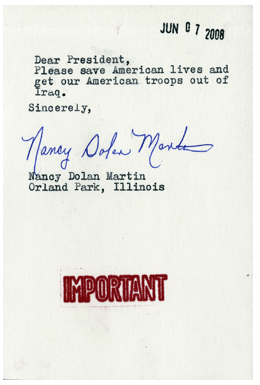
Wrote one person: "I voted for Nixon twice, I voted for Reagan twice, I voted for your father. You and your administration deeply trouble, anger and outrage me."
"I am a Christian not voting for you," wrote another.
Still another's postcard began: "Here are our terms for your surrender."
In California, a woman wrote to the president about health care.
"If I were president," she wrote, "I would give every American the same health-care coverage that you and every member of the House and Senate get."
In Brooklyn last weekend, a little girl asked Oring to write a note about the war.
"Dear Mr. President, bring my uncle home," she wrote. "My aunt needs him."
While the Whitehouse maintained privacy of people's correspondence to the President, Sheryl was inspired by the transformation that the people themselves feel through the simple process of expression.
Curator and Art Historian